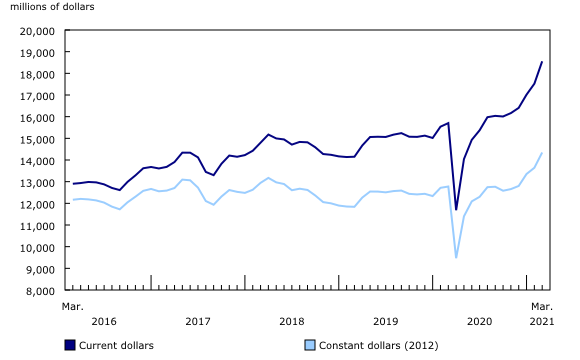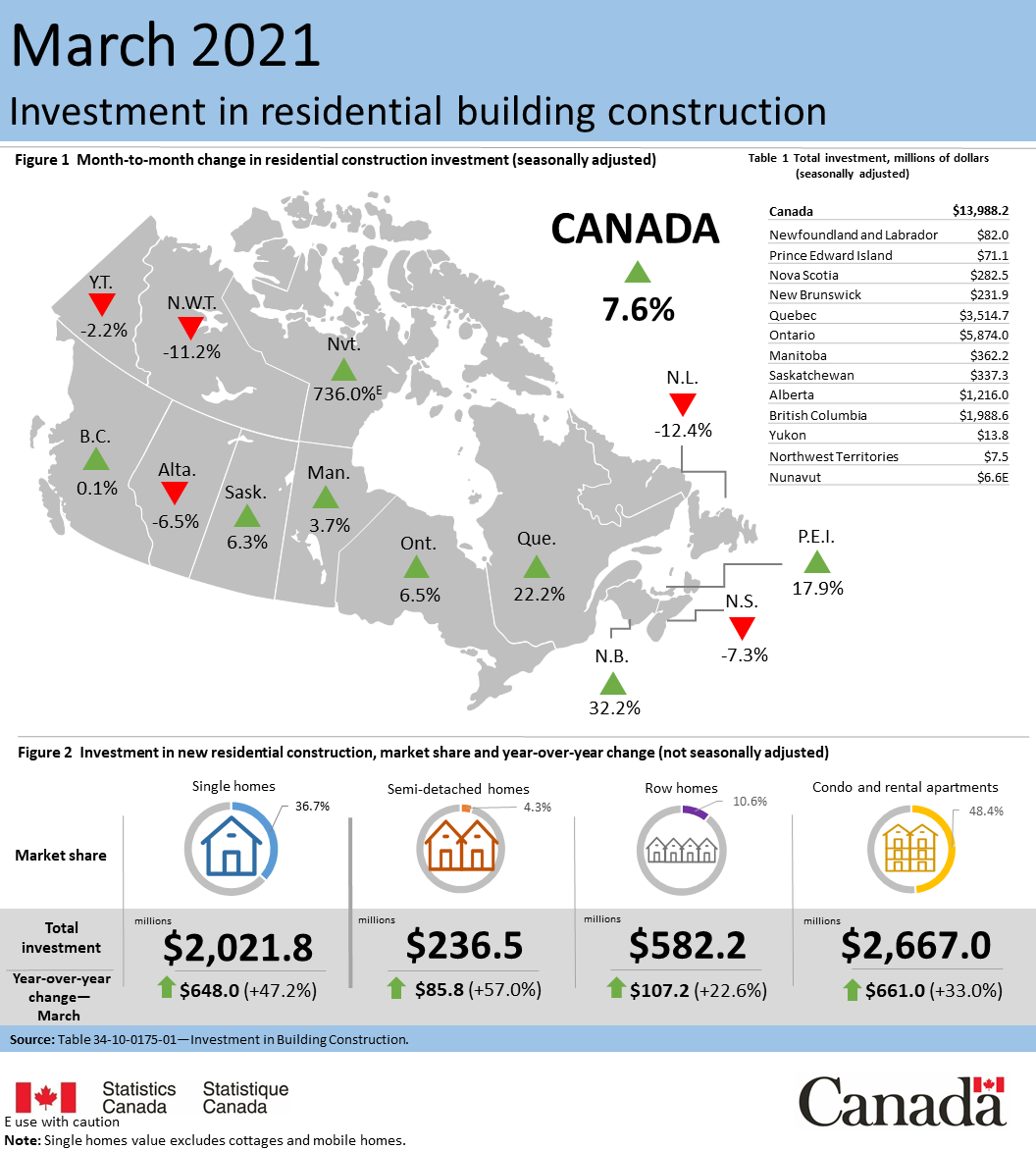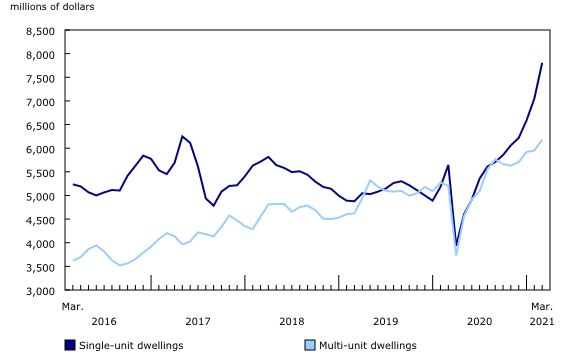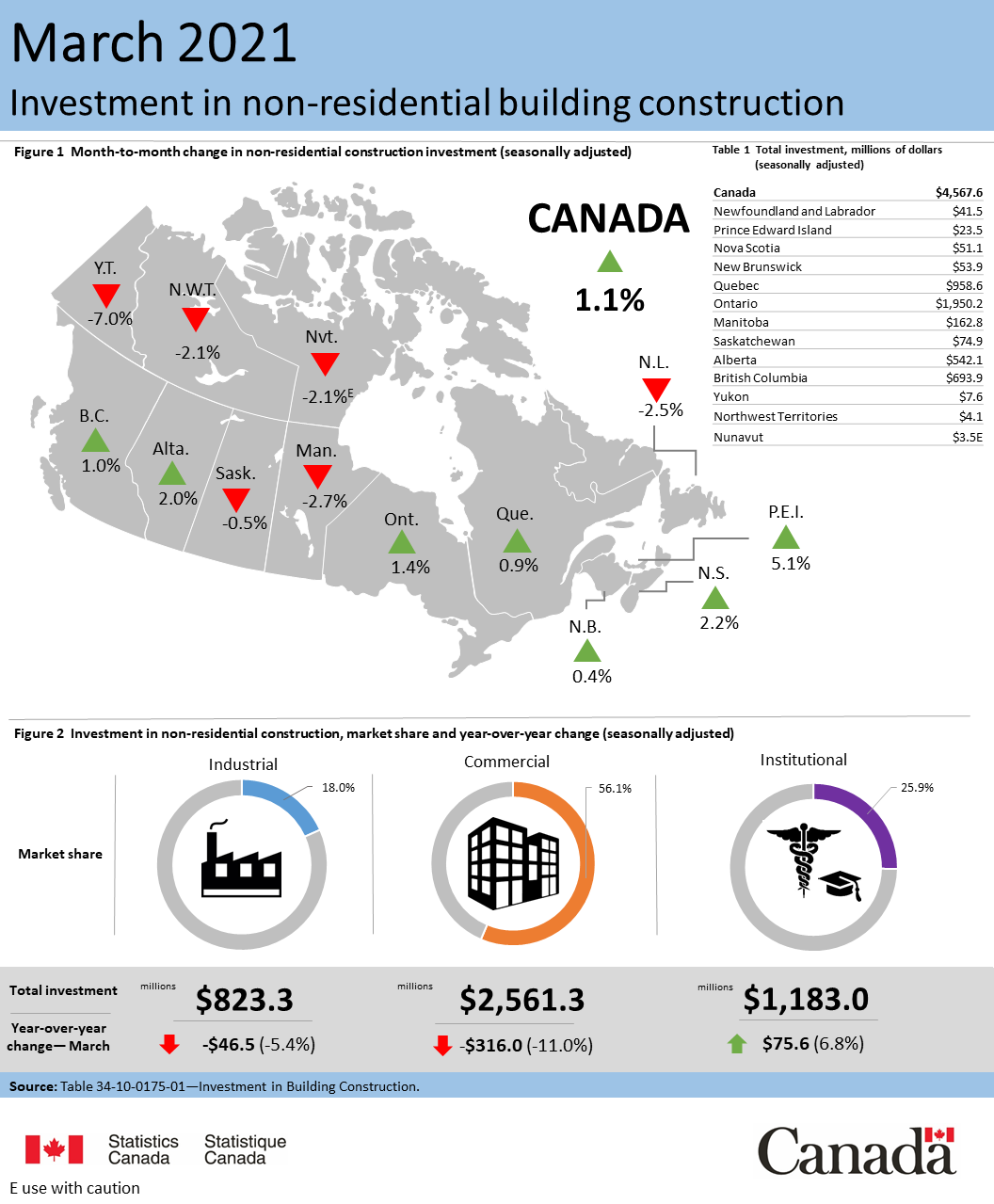Investment in building construction, March 2021
Archived Content
Information identified as archived is provided for reference, research or recordkeeping purposes. It is not subject to the Government of Canada Web Standards and has not been altered or updated since it was archived. Please "contact us" to request a format other than those available.
Released: 2021-05-12
$18.6 billion
March 2021
5.9% 
(monthly change)
Total investment in building construction increased 5.9% to $18.6 billion in March, led by the residential sector.
On a constant dollar basis (2012=100), investment in building construction was up 5.2% to $14.3 billion in March.
Residential investment continues to set records
Residential construction investment increased for the eleventh consecutive month, up 7.6% to $14.0 billion in March.
Investment in single units jumped 10.7% to $7.8 billion. Quebec led the way with an increase of 30.4%, bringing investment in single homes to $1.9 billion for the province. Investment in Ontario was up 9.8% to $3.3 billion, driven by renovations to single family homes in the census metropolitan area of Toronto.
Growth in multi-unit construction continued, up 3.9% to $6.2 billion. Gains in Quebec and Ontario led the overall increase in this component, as six provinces reported declines. Both new construction and renovations of condominiums and apartments in the cities of Toronto and Montréal accounted for most of the growth.
Non-residential investment increases slightly
Non-residential construction investment rose 1.1% to $4.6 billion in March, with all components posting slight increases. Despite this gain, the commercial and industrial investment components were below pre-COVID-19 pandemic levels.
Institutional construction investment was up 2.2% to $1.2 billion. Multiple high-value projects in Montréal contributed to a 2.6% increase in Quebec, where investment totalled $315 million in March. Investments in the province included a new elementary school in Laval and renovations to a secondary school in Montréal. British Columbia recorded another strong month in March, with the continued construction of new schools in Burnaby, North Vancouver and Vancouver.
Commercial building construction rose 0.8% to $2.6 billion. Six provinces recorded slight gains, led by Ontario and Alberta. Large office building renovation projects in Edmonton and Calgary contributed to the 1.7% gain in Alberta in this component.
Investment in industrial construction edged up 0.4% to $823 million in March. Increases in Ontario, British Columbia, Prince Edward Island and Quebec offset six provincial declines.
Residential investment drives first quarter of the year
The total value of investment in building construction rose 9.3% to $53.1 billion in the first quarter, stemming from continued strength in the residential sector (+12.4%). Investment for residential buildings reached $39.5 billion, largely because of increased spending on single units in Ontario (+21.8%) and Quebec (+24.9%).
Non-residential investment rose 1.1% to $13.6 billion in the first quarter, following a 6.0% decline in the previous quarter.
Institutional construction advanced 3.0% in the first quarter, driven by strength in British Columbia and Newfoundland and Labrador, which recorded their highest levels for this component since the start of the series in 2010. Nova Scotia jumped 55.0%, reporting the highest quarterly value since the third quarter of 2014.
Investment in commercial construction advanced slightly compared with the fourth quarter of 2020, with the gain largely due to strength in Ontario. However, investment in this component was below pre-COVID-19 pandemic levels, down 13.8% compared with the first quarter of 2020.
The industrial component edged down 0.2%, largely as a result of declines in Alberta.
For more information on housing, please visit the Housing Statistics Portal.
Note to readers
Based on the extraordinary events and business disruptions related to the COVID-19 pandemic, Statistics Canada continues to make adjustments to the models used to estimate investment in building construction. As a result of these adjustments, there may be larger-than-normal revisions to the data.
Revision
Unadjusted data for the current reference month are subject to revision based on late responses. As per Statistics Canada practices, data for the previous year have been revised. Seasonally adjusted data for the previous three years have also been revised.
Data presented in this release are seasonally adjusted with current dollar values unless otherwise stated. Using seasonally adjusted data allows month-to-month comparisons by removing the effects of seasonal variations. For information on seasonal adjustment, see Seasonally adjusted data – Frequently asked questions.
Monthly estimates in constant dollars are calculated using quarterly deflators from the Building Construction Price Index (Table 18-10-0135-01). Typically, the first two months of a quarter use the previous quarter's price level and are revised when the new quarterly price index becomes available.
Detailed data on investment activity by type of building and type of work are now available in the unadjusted current dollar series.
Prior to January 2018, building permits for cottages with a value greater than $60,000 were automatically reclassified to the structure type "single." Beginning in January 2018, regardless of value, building permits received from municipalities coded as cottages remain classified as a cottage.
Effective November 23, 2018, Table 34-10-0175-01 contains data on both the residential and the non-residential sectors. It replaced tables 34-10-0010-01, 34-10-0011-01 and 34-10-0012-01.
Next release
Data on investment in building construction for April will be released on June 10.
Products
A study titled "Price trends and outlook in key Canadian housing markets" looks at where the housing market was at the onset of the COVID-19 pandemic, sheds light on what has happened since then and explores the challenges facing the Canadian market going forward.
Statistics Canada has a "Housing Market Indicators" dashboard. This web application provides access to key housing market indicators for Canada, by province and by census metropolitan area. These indicators are updated automatically with new information from monthly releases, giving users access to the latest data.
Contact information
For more information, or to enquire about the concepts, methods or data quality of this release, contact us (toll-free 1-800-263-1136; 514-283-8300; STATCAN.infostats-infostats.STATCAN@canada.ca) or Media Relations (613-951-4636; STATCAN.mediahotline-ligneinfomedias.STATCAN@canada.ca).
- Date modified:





